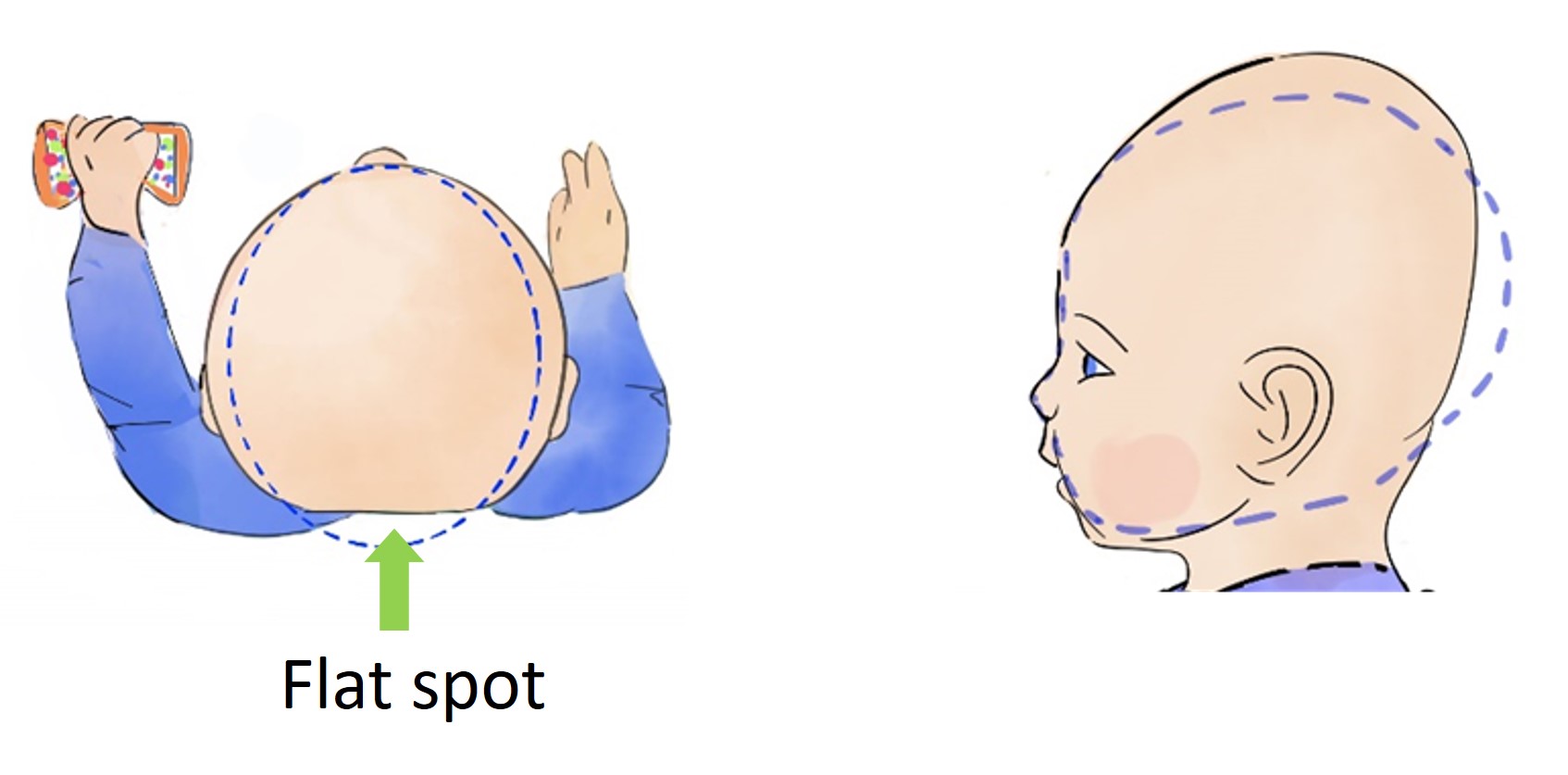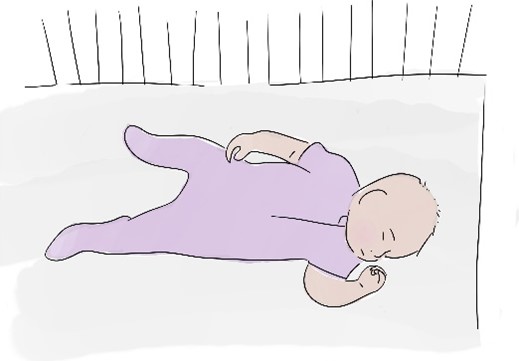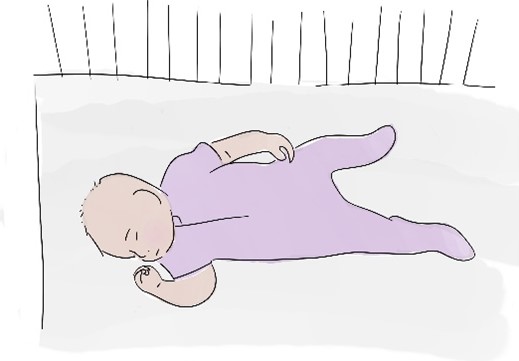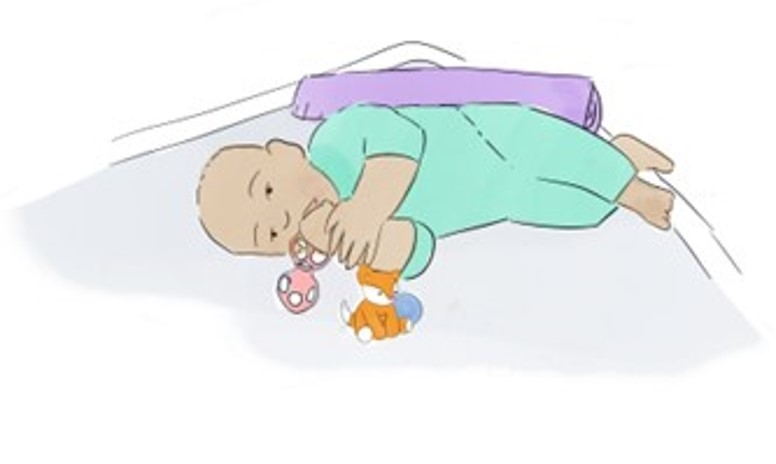Positional Plagiocephaly and Brachycephaly
Tips for parents
Head shape changes are common in babies. A flat area can develop quickly on your baby’s head in the first 4 months. Most often, flat spots develop from your baby lying with their head in the same position for long periods of time. The 2 most common changes to head shape are plagiocephaly and brachycephaly.
Positional plagiocephaly
If your baby has a flat spot on one side of the back of their head, this is called plagiocephaly. You may notice that their ear, forehead, and cheek may be more forward on the same side as the flat spot.
 Blue dotted line indicates typical head shape
Blue dotted line indicates typical head shapeBrachycephaly
If your baby has a flat spot across the back of their head, this is called brachycephaly. You may notice widening across the back of the head, or the forehead sloping upward from the front to the back of the head.
 Blue dotted line indicates typical head shape
Blue dotted line indicates typical head shapeFlat spots can be prevented and treated when caught early. If there’s a large head shape change, your doctor may recommend other treatment and more support from a pediatric physiotherapist.
What causes it?
A baby’s head shape may be affected by how the baby was positioned before they were born. It can also be affected by the birth process. These changes will usually resolve in the first few weeks following birth.
Following birth, babies spend lots of time in car seats, swings, and other seats. This can lead to a flat area on their head. Torticollis can also lead to a flat area on your baby’s head. Torticollis is a problem with your baby’s neck muscles that causes them to keep their head turned to one side. If your baby has a torticollis, your doctor may recommend neck exercises and refer you to a pediatric physiotherapist.
How is plagiocephaly treated?
If your baby has a flat spot that is on one side of the back of their head, this is called plagiocephaly. The goal is to keep the flat spot up and out, away from the pressure of resting on firm surfaces.

- Place your baby on their back every sleep. Place their head to the end of the crib that encourages them to look to the side that keeps the flat spot up.
- Avoid using overhead mobiles. Keep everything interesting on the side you want your baby to look toward. Babies will usually turn to look out into the room, toward doors or toward you.
- Don’t use positioning devices in the crib.
- Use lots of tummy time when awake. Hold them tummy to tummy, place them on their tummy over your lap, carry them tummy down, or do tummy time on the floor.
- Limit the use of baby seats and swings. Try a baby wrap or baby carrier instead. These don’t place pressure on the head.
- Have your baby play while lying on their side with the round part of their head in contact with the ground. This keeps the flat spot up. You can place a rolled towel or blanket behind their hip and shoulder to keep them from rolling onto their back.

To help you remember which side the flat spot is on, try using a soft wrist rattle or a soft wrist cuff. You can make one by cutting the cuff off a baby sock. Don’t use anything with beads or small pieces. These can be a choking hazard for your baby.
How is brachycephaly treated?
If your baby has a flat spot across the back of their head, this is called brachycephaly. The goal for treatment is to take pressure off the back of the head.
 Looking left
Looking left Looking right
Looking right- Place your baby on their back every sleep. Place them in their crib with the head in the opposite direction as the previous night. This will help your baby turn their head to both sides while sleeping.
- Avoid using overhead mobiles.
- Don’t use positioning devices in the crib.
- Use lots of tummy time when awake. Hold your baby tummy to tummy, place them on their tummy over your lap, carry them tummy down, or do tummy time on the floor.
- When your baby is lying on their back, encourage them to look to both sides rather than looking straight up. Keep all toys and people to the sides, rather than straight overhead.
- Limit the use of baby seats and swings. Try a baby wrap or baby carrier instead. These don’t place pressure on the head.
- Have your baby play while lying on both their left and right sides. You can place a rolled towel or blanket behind their hip and shoulder to keep them from rolling onto their back. This takes pressure off the back of the head. The pressure of the sides of the head with the floor will help to improve your baby’s head shape.
 Lying on left side
Lying on left side Lying on right side
Lying on right sideWhen should you call for help?
It’s important to make sure to get advice from your doctor and a physiotherapist if you notice changes in your baby’s head shape. Your baby will have the best results if you notice changes early and deal with them right away.
See your doctor and a physiotherapist for more help if you’ve been using these positioning strategies consistently and your baby is 5 months or older and still has changes in their head shape.
To see this information online and learn more, visit MyHealth.Alberta.ca/health/aftercareinformation/pages/conditions.aspx?hwid=custom.ab_positional_plagio_brachycephaly_inst.

For 24/7 nurse advice and general health information call Health Link at 811.
Current as of: November 24, 2023
Author: Pediatric Rehabilitation Services, Alberta Health Services
This material is not a substitute for the advice of a qualified health professional. This material is intended for general information only and is provided on an "as is", "where is" basis. Although reasonable efforts were made to confirm the accuracy of the information, Alberta Health Services does not make any representation or warranty, express, implied or statutory, as to the accuracy, reliability, completeness, applicability or fitness for a particular purpose of such information. Alberta Health Services expressly disclaims all liability for the use of these materials, and for any claims, actions, demands or suits arising from such use.
